technical data MERCEDES-BENZ METRIS 2020 MY20 Operator’s Manual
[x] Cancel search | Manufacturer: MERCEDES-BENZ, Model Year: 2020, Model line: METRIS, Model: MERCEDES-BENZ METRIS 2020Pages: 320, PDF Size: 26.38 MB
Page 307 of 320
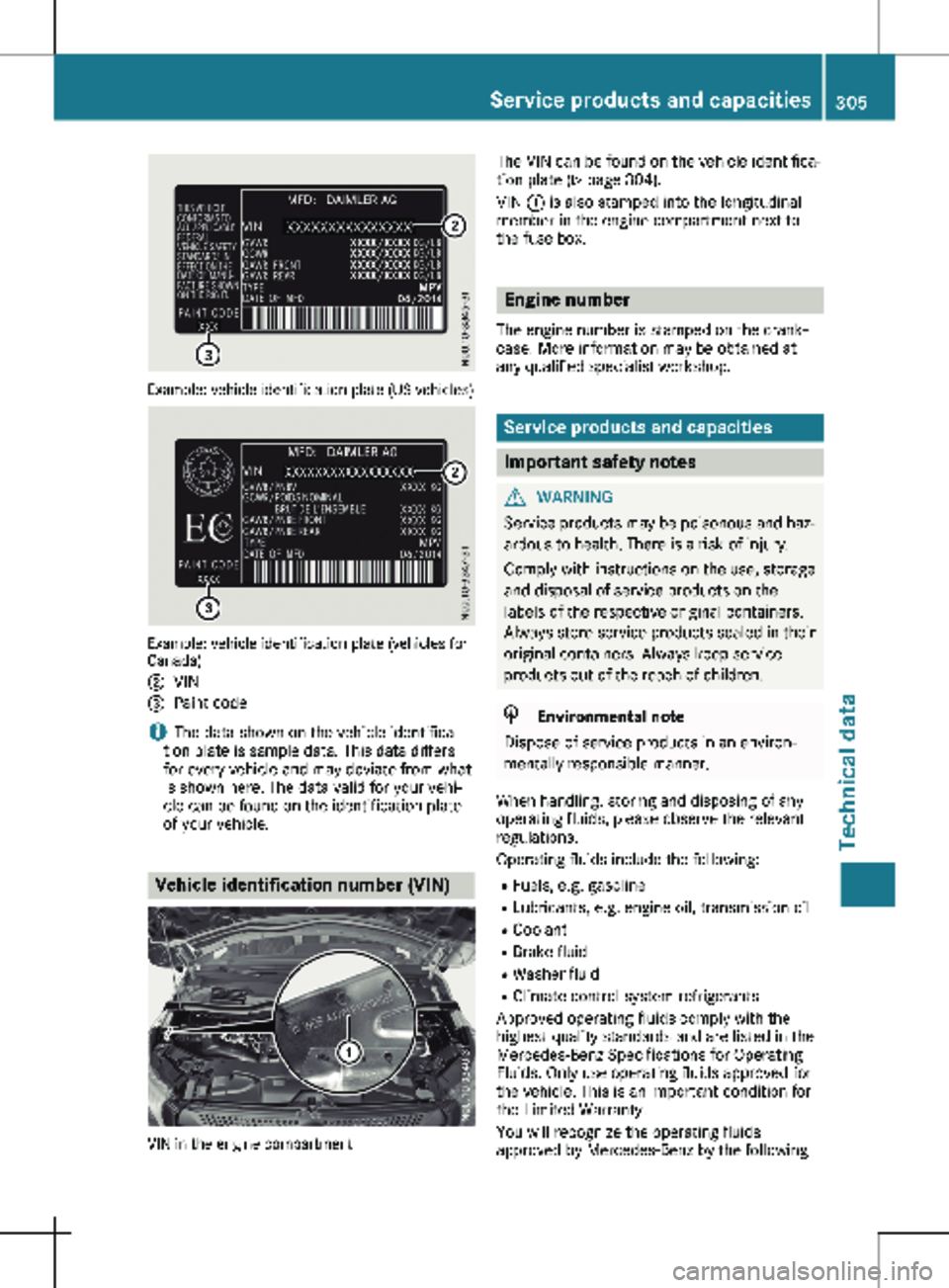
Example: vehicle identification plate (US vehicles)
Example: vehicle identification plate (vehicles for
Canada)
; VIN
= Paint code
i The data shown on the vehicle identifica-
tion plate is sample data. This data differs
for every vehicle and may deviate from what
is shown here. The data valid for your vehi-
cle can be found on the identification plate
of your vehicle. Vehicle identification number (VIN)
VIN in the engine compartment The VIN can be found on the vehicle identifica-
tion plate (Y page
304).
VIN : is also stamped into the longitudinal
member in the engine compartment next to
the fuse box. Engine number
The engine number is stamped on the crank-
case. More information may be obtained at
any qualified specialist workshop. Service products and capacities
Important safety notes
G
WARNING
Service products may be poisonous and haz-
ardous to health. There is a risk of injury.
Comply with instructions on the use, storage
and disposal of service products on the
labels of the respective original containers.
Always store service products sealed in their
original containers. Always keep service
products out of the reach of children. H
Environmental note
Dispose of service products in an environ-
mentally responsible manner.
When handling, storing and disposing of any
operating fluids, please observe the relevant
regulations.
Operating fluids include the following:
R Fuels, e.g. gasoline
R Lubricants, e.g. engine oil, transmission oil
R Coolant
R Brake fluid
R Washer fluid
R Climate control system refrigerants
Approved operating fluids comply with the
highest quality standards and are listed in the
Mercedes-Benz Specifications for Operating
Fluids. Only use operating fluids approved for
the vehicle. This is an important condition for
the Limited Warranty.
You will recognize the operating fluids
approved by Mercedes-Benz by the following Service products and capacities
305
Technical data Z
Page 308 of 320
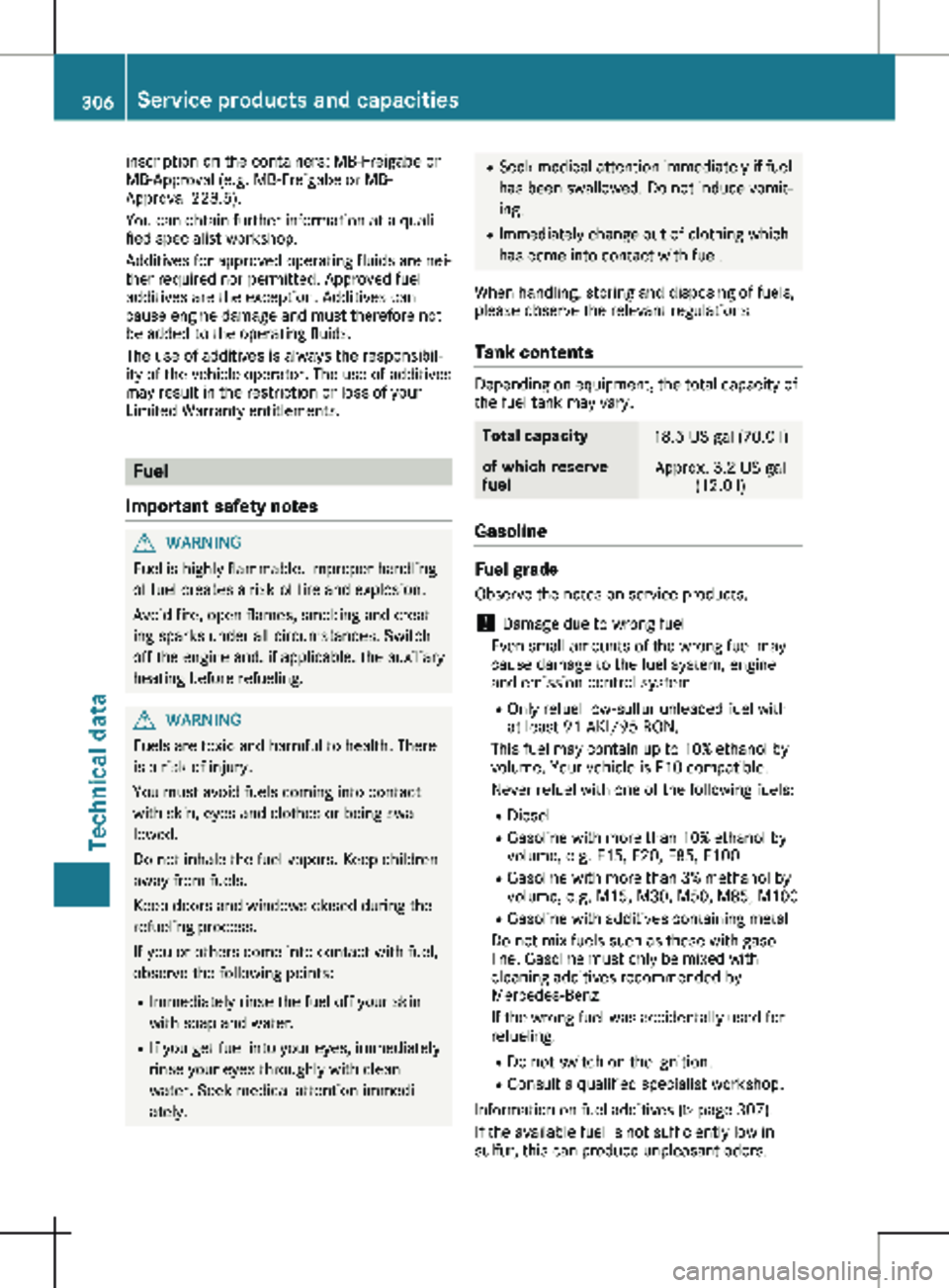
inscription on the containers: MB-Freigabe or
MB-Approval (e.g. MB-Freigabe or MB-
Approval 228.5).
You can obtain further information at a quali-
fied specialist workshop.
Additives for approved operating fluids are nei-
ther required nor permitted. Approved fuel
additives are the exception. Additives can
cause engine damage and must therefore not
be added to the operating fluids.
The use of additives is always the responsibil-
ity of the vehicle operator. The use of additives
may result in the restriction or loss of your
Limited Warranty entitlements. Fuel
Important safety notes G
WARNING
Fuel is highly flammable. Improper handling
of fuel creates a risk of fire and explosion.
Avoid fire, open flames, smoking and creat-
ing sparks under all circumstances. Switch
off the engine and, if applicable, the auxiliary
heating before refueling. G
WARNING
Fuels are toxic and harmful to health. There
is a risk of injury.
You must avoid fuels coming into contact
with skin, eyes and clothes or being swal-
lowed.
Do not inhale the fuel vapors. Keep children
away from fuels.
Keep doors and windows closed during the
refueling process.
If you or others come into contact with fuel,
observe the following points:
R Immediately rinse the fuel off your skin
with soap and water.
R If you get fuel into your eyes, immediately
rinse your eyes throughly with clean
water. Seek medical attention immedi-
ately. R
Seek medical attention immediately if fuel
has been swallowed. Do not induce vomit-
ing.
R Immediately change out of clothing which
has come into contact with fuel.
When handling, storing and disposing of fuels,
please observe the relevant regulations.
Tank contents Depending on equipment, the total capacity of
the fuel tank may vary.
Total capacity
18.5 US gal (70.0 l)
of which reserve
fuel
Approx. 3.2 US gal
(12.0 l ) Gasoline
Fuel grade
Observe the notes on service products.
! Damage due to wrong fuel
Even small amounts of the wrong fuel may
cause damage to the fuel system, engine
and emission control system.
R Only refuel low-sulfur unleaded fuel with
at least
91 AKI/95 RON.
This fuel may contain up to 10% ethanol by
volume. Your vehicle is E10 compatible.
Never refuel with one of the following fuels:
R Diesel
R Gasoline with more than 10% ethanol by
volume, e.g. E15, E20, E85, E100
R Gasoline with more than 3% methanol by
volume, e.g. M15, M30, M50, M85, M100
R Gasoline with additives containing metal
Do not mix fuels such as these with gaso-
line. Gasoline must only be mixed with
cleaning additives recommended by
Mercedes-Benz.
If the wrong fuel was accidentally used for
refueling:
R Do not switch on the ignition.
R Consult a qualified specialist workshop.
Information on fuel additives (Y page 307). If the available fuel is not sufficiently low in
sulfur, this can produce unpleasant odors. 306
Service products and capacities
Technical data
Page 309 of 320

!
Filter the fuel before transferring it to the
vehicle if you are refueling the vehicle from
barrels or containers.
This will prevent malfunctions in the fuel
system due to contaminated fuel.
i E10 fuel contains an admixture of up to
10% bioethanol. Your vehicle is E10 compat-
ible. You can refuel your vehicle with E10
fuel.
i You can obtain information on fuel grades
at a qualified specialist workshop or at a gas
station. If there is no identification on the
filling pump, consult a gas station attendant.
For more information about refueling
(Y page
136).
Fuel additives
! Operating the engine with subsequently
added fuel additives can cause engine dam-
age. Do not mix fuel additives with fuel. This
does not include additives for the removal
and prevention of deposits. Gasoline can
only be mixed with additives recommended
by Mercedes-Benz. Follow the instructions
in the product description. You can find fur-
ther information on recommended additives
in any Mercedes-Benz Commercial Van Cen-
ter.
Mercedes-Benz recommends using brand-
name fuels with additives.
If you use fuels without these additives for a
long period of time, deposits can form. This
primarily forms on the inlet valve and in the
combustion chamber.
In some countries, the available fuel grade
may be inadequate. Residue could build up in
the fuel injection system as a result. In this
case, in consultation with a Mercedes-Benz
Commercial Van Center, the fuel should be
mixed with the cleaning additive recommen-
ded by Mercedes-Benz. You must observe the
notes and mixing ratios indicated on the con-
tainer.
Do not add other fuel additives to the fuel.
This results in unnecessary costs and can
damage the engine. Information on fuel consumption H
Environmental note
CO 2 (carbon dioxide) is the gas that accord-
ing to the current state of knowledge is
mainly responsible for the heating of the
earth's atmosphere (greenhouse effect). The
CO 2 emissions of your vehicle vary in direct
correspondence with the fuel consumption
and is therefore dependent on:
R the efficient utilization of the fuel by the
engine
R the respective style of driving
R other non-technical factors, such as envi-
ronmental influences, condition of the
road or traffic flow, for example
You can help to minimize CO 2 emissions
with a conservative driving style and regular
maintenance of your vehicle .
Only for certain countries: the respective cur-
rent consumption and emission values of your
vehicle can be found in the COC papers (EC
CERTIFICATE OF CONFORMITY). These docu-
ments are supplied when the vehicle is deliv-
ered.
Consumption figures were found in the cur-
rently valid respective version: R for vehicles with exhaust gas standard Euro
6 as per directive (EC) no. 715/2007
R for vehicles with exhaust gas standard
EURO VI as per directive (EC) no. 595/2009
Fuel consumption depends on:
R the vehicle version
R the style of driving
R the operating conditions
R the fuel type and fuel grade used
The vehicle will use more fuel than usual in the
following situations:
R at very low outside temperatures
R in city traffic
R during short journeys
R on mountainous terrain
R when towing a trailer
Observe the advice in the "Protection of the
environment" section to keep fuel consump-
tion low
(Y page 29). Service products and capacities
307
Technical data Z
Page 310 of 320
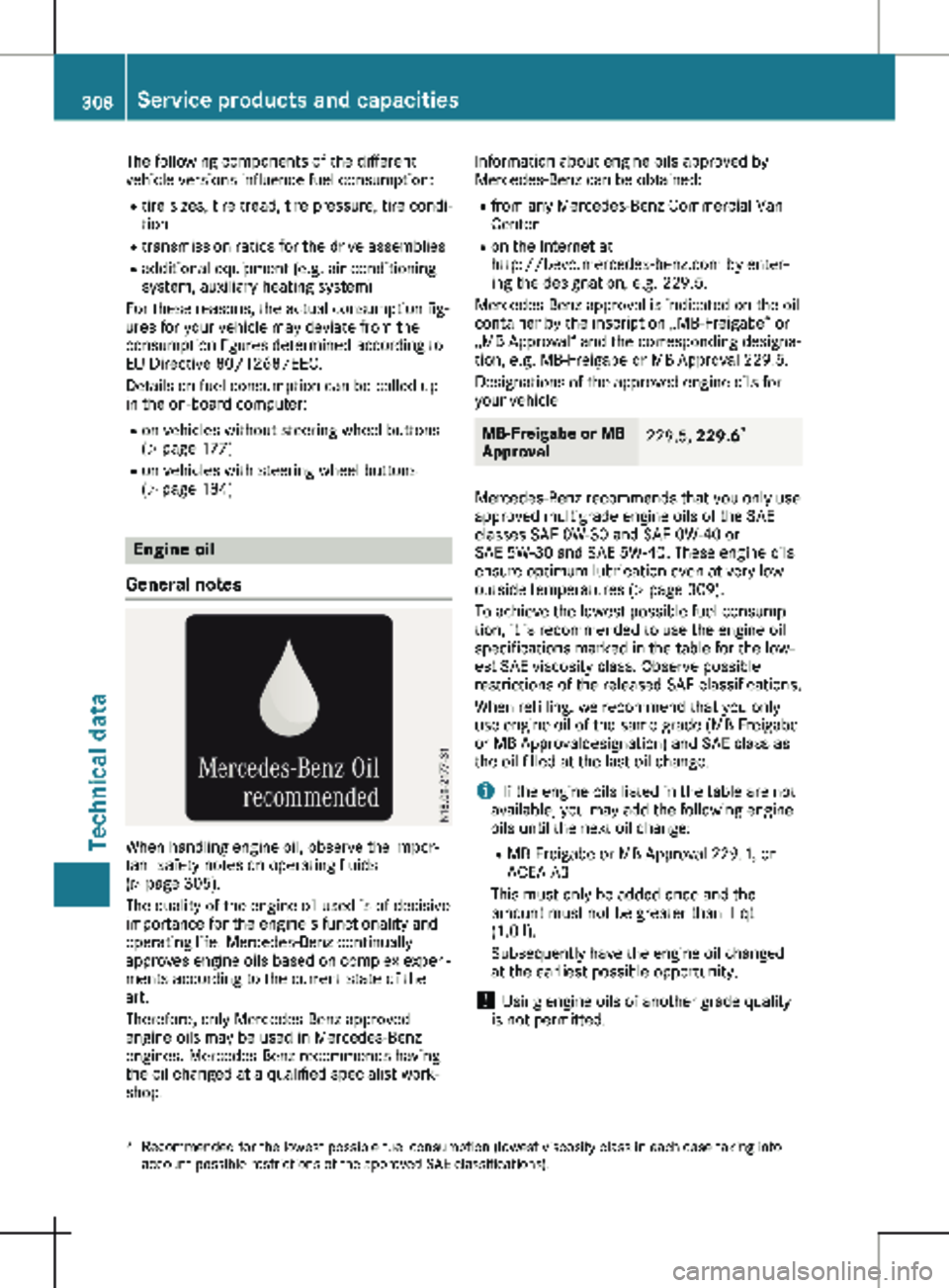
The following components of the different
vehicle versions influence fuel consumption:
R tire sizes, tire tread, tire pressure, tire condi-
tion
R transmission ratios for the drive assemblies
R additional equipment (e.g. air-conditioning
system, auxiliary heating system)
For these reasons, the actual consumption fig-
ures for your vehicle may deviate from the
consumption figures determined according to
EU Directive
80/1268/EEC.
Details on fuel consumption can be called up
in the on-board computer:
R on vehicles without steering wheel buttons
(Y page 177)
R on vehicles with steering wheel buttons
(Y page 184) Engine oil
General notes When handling engine oil, observe the impor-
tant safety notes on operating fluids
(Y page
305).
The quality of the engine oil used is of decisive
importance for the engine's functionality and
operating life. Mercedes-Benz continually
approves engine oils based on complex experi-
ments according to the current state of the
art.
Therefore, only Mercedes-Benz approved
engine oils may be used in Mercedes-Benz
engines. Mercedes-Benz recommends having
the oil changed at a qualified specialist work-
shop. Information about engine oils approved by
Mercedes-Benz can be obtained:
R from any Mercedes-Benz Commercial Van
Center
R on the Internet at
http://bevo.mercedes-benz.com
by enter-
ing the designation, e.g. 229.5.
Mercedes-Benz approval is indicated on the oil
container by the inscription „MB-Freigabe“ or
„MB Approval“ and the corresponding designa-
tion, e.g. MB-Freigabe or MB Approval 229.5.
Designations of the approved engine oils for
your vehicle MB-Freigabe or MB
Approval
229.5,
229.62 Mercedes-Benz recommends that you only use
approved multigrade engine oils of the SAE
classes
SAE 0W-30 and SAE 0W-40 or
SAE 5W-30 and SAE 5W-40. These engine oils
ensure optimum lubrication even at very low
outside temperatures (Y page 309).
To achieve the lowest possible fuel consump-
tion, it is recommended to use the engine oil
specifications marked in the table for the low-
est SAE viscosity class. Observe possible
restrictions of the released SAE classifications.
When refilling, we recommend that you only
use engine oil of the same grade (MB-Freigabe
or MB Approvaldesignation) and SAE class as
the oil filled at the last oil change.
i If the engine oils listed in the table are not
available, you may add the following engine
oils until the next oil change:
R MB-Freigabe or MB Approval 229.1, or
ACEA A3
This must only be added once and the
amount must not be greater than 1 qt
(1.0 l).
Subsequently have the engine oil changed
at the earliest possible opportunity.
! Using engine oils of another grade quality
is not permitted.
2 Recommended for the lowest possible fuel consumption (lowest viscosity class in each case taking into
account possible restrictions of the approved SAE classifications). 308
Service products and capacities
Technical data
Page 311 of 320
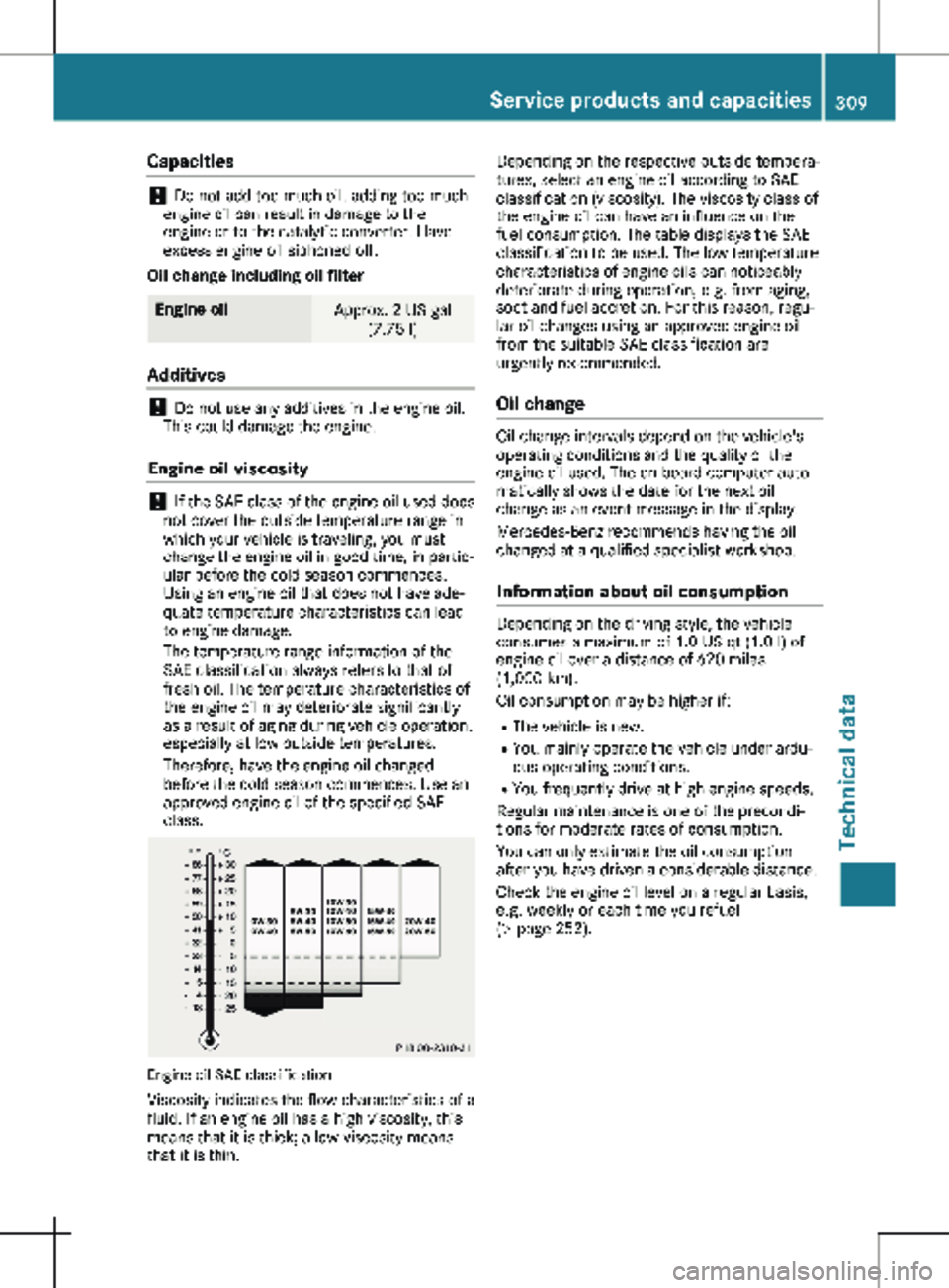
Capacities
!
Do not add too much oil. adding too much
engine oil can result in damage to the
engine or to the catalytic converter. Have
excess engine oil siphoned off.
Oil change including oil filter Engine oil
Approx. 2 US gal
(7.75 l )Additives
!
Do not use any additives in the engine oil.
This could damage the engine.
Engine oil viscosity !
If the SAE class of the engine oil used does
not cover the outside temperature range in
which your vehicle is traveling, you must
change the engine oil in good time, in partic-
ular before the cold season commences.
Using an engine oil that does not have ade-
quate temperature characteristics can lead
to engine damage.
The temperature range information of the
SAE classification always refers to that of
fresh oil. The temperature characteristics of
the engine oil may deteriorate significantly
as a result of aging during vehicle operation,
especially at low outside temperatures.
Therefore, have the engine oil changed
before the cold season commences. Use an
approved engine oil of the specified SAE
class. Engine oil SAE classification
Viscosity indicates the flow characteristics of a
fluid. If an engine oil has a high viscosity, this
means that it is thick; a low viscosity means
that it is thin. Depending on the respective outside tempera-
tures, select an engine oil according to SAE
classification (viscosity). The viscosity class of
the engine oil can have an influence on the
fuel consumption. The table displays the SAE
classification to be used. The low temperature
characteristics of engine oils can noticeably
deteriorate during operation, e.g. from aging,
soot and fuel accretion. For this reason, regu-
lar oil changes using an approved engine oil
from the suitable SAE classification are
urgently recommended.
Oil change Oil change intervals depend on the vehicle's
operating conditions and the quality of the
engine oil used. The on-board computer auto-
matically shows the date for the next oil
change as an event message in the display.
Mercedes-Benz recommends having the oil
changed at a qualified specialist workshop.
Information about oil consumption Depending on the driving style, the vehicle
consumes a maximum of 1.0 US qt
(1.0 l) of
engine oil over a distance of 620 miles
(1,000 km).
Oil consumption may be higher if:
R The vehicle is new.
R You mainly operate the vehicle under ardu-
ous operating conditions.
R You frequently drive at high engine speeds.
Regular maintenance is one of the precondi-
tions for moderate rates of consumption.
You can only estimate the oil consumption
after you have driven a considerable distance.
Check the engine oil level on a regular basis,
e.g. weekly or each time you refuel
( Y page 252). Service products and capacities
309
Technical data Z
Page 312 of 320

Transmission oil
Automatic transmission Operating fluid: automatic transmission
fluid Product name/number Maintenance
interval Mobil ATF 134 FE
Valvoline ATF Pro 236.15
MB Sheet No. 236.15 —
More information can be obtained at any quali-
fied specialist workshop.
Rear axle Operating fluid: transmission oil
Product name/number Maintenance
interval Mobilube FE 75W-85
Mobilube FE Plus NG
75W-85
MB Sheet No. 235.7 —
More information can be obtained at any quali-
fied specialist workshop.
Brake fluid
G
WARNING
The brake fluid constantly absorbs moisture
from the air. This lowers the boiling point of
the brake fluid. If the boiling point of the
brake fluid is too low, vapor pockets may
form in the brake system when the brakes
are applied hard. This would impair braking
efficiency. There is a risk of an accident.
You should have the brake fluid renewed at
the specified intervals.
! Brake fluid corrodes paint, plastic and rub-
ber. If paint, plastic or rubber has come into
contact with brake fluid, rinse with water
immediately.
When handling, storing and disposing of brake
fluid, please observe the relevant regulations and the important safety notes for service
products (Y page
305).
Over a period of time, the brake fluid absorbs
moisture from the air. This reduces its boiling
point.
Have the brake fluid replaced at specified
intervals by a qualified specialist workshop.
i There is usually a notice in the engine
compartment to remind you when the next
brake fluid change is due.
Use only approved brake fluids that comply
with the Mercedes-Benz Specifications for Ser-
vice Products. Always check for the identifica-
tion DOT 4 plus.
Information about approved brake fluids can
be obtained:
R on the Internet at
http://bevo.mercedes-benz.com. Coolant
Important safety notes G
WARNING
If antifreeze comes into contact with hot
components in the engine compartment, it
may ignite. There is a risk of fire and injury.
Let the engine cool down before you add
antifreeze. Make sure that antifreeze is not
spilled next to the filler neck. Thoroughly
clean the antifreeze from components
before starting the engine.
! Take care not to spill any coolant on pain-
ted surfaces. You could otherwise damage
the paintwork.
When handling, storing and disposing of cool-
ant and antifreeze, please observe the relevant
regulations and the important safety notes for
operating fluids
(Y page 305).
Coolant additive with corrosion and
antifreeze protection !
Use only approved antifreeze/corrosion
inhibitor that complies with MB Specifica-
tion for Service Products, Sheet Number
325. Using other, non-approved antifreeze/
corrosion inhibitors may cause damage to 310
Service products and capacities
Technical data
Page 313 of 320

the coolant system and reduce the engine's
service life.
The coolant is a mixture of water and anti-
freeze and corrosion inhibitor. It performs the
following tasks:
R Anti-corrosion protection
R Antifreeze protection
R Raises the boiling point
When the vehicle is first delivered, it is filled
with a coolant mixture that ensures adequate
antifreeze/corrosion protection. Coolant must
remain in the engine cooling system all year
round to ensure anti-corrosion protection and
a higher boiling point, even in countries with
high outside temperatures.
Check the antifreeze/corrosion inhibitor con-
centration in the coolant every six months.
The percentage of corrosion inhibitor/anti-
freeze additive in the engine cooling system
should:
R be at least
50%. This way, the engine cooling
system is protected against freezing down
to approximately -35 ‡ (-37 †).
R not exceed 55% (antifreeze protection down
to -49 ‡ [-45 †]). Otherwise, heat will not
be dissipated as effectively.
Mercedes-Benz recommends an antifreeze and
corrosion inhibitor that meets the require-
ments in the Mercedes-Benz Specifications for
Service Products Sheet Number 325.
More information can be obtained at any quali-
fied specialist workshop.
Operating fluid: coolant Product name/number
Zerex G40-91, The Valvoline Company
MB Sheet No. 325.5
Maintenance interval
Have the coolant replaced at specified inter-
vals by a qualified specialist workshop.
Capacities Engine cooling system
Coolant
Approx. 11 US qt
(10.4 l
) Climate control system refrigerants
Important safety notes The climate control system of your vehicle is
filled with the refrigerant R ‑134a.
The warning label for the refrigerant being
used can be found on the radiator cross mem-
ber.
! Only the refrigerant R‑134a and the PAG
oil approved by Mercedes-Benz may be
used. The approved PAG oil may not be
mixed with any other PAG oil that is not
approved for R-134a refrigerant. Otherwise,
the climate control system may be dam-
aged.
Maintenance work such as adding refrigerant
or replacing components may only be carried
out by a qualified specialist workshop. All
applicable regulations thereto and the SAE
standard J639 must be adhered to.
All work on the climate control system should
always be carried out at qualified specialist
workshop.
Refrigerant warning label Refrigerant warning label (example)
: Warning symbols
; Refrigerant capacity
= Applicable standards
? Part number PAG oil
A Type of refrigerant
The symbol : refers to:
R possible dangers
R the implementation of maintenance work at
a qualified specialist workshop Service products and capacities
311
Technical data Z
Page 314 of 320

Capacities
Front-compartment
air-conditioning
system Capacity
Refrigerant
21.2 oz
(600 g) PAG oil
2.8 oz
( 79 g) Rear-compartment
air-conditioning
system Capacity
Refrigerant
33.5 oz
(950 g) PAG oil
4.9 oz
(139 g) Washer fluid
Important safety notes G
WARNING
Windshield washer concentrate is highly
flammable. If windshield washer concentrate
gets onto hot components of the engine or
the exhaust system, it can ignite. There is a
risk of fire and injury.
Make sure that windshield washer concen-
trate is not spilled in the vicinity of the filler
neck.
! Only use washer fluid which is suitable for
lamp lenses, e.g. MB SummerFit or MB Win-
terFit. Unsuitable washer fluid may damage
the lamp lenses of the headlamps.
When handling washer fluid, observe the
important safety notes on service products
(Y page
305).
Mixing ratio Add windshield washer concentrate to the
washer fluid all year round. Adapt the mixing
ratio to the ambient temperature. At temperatures above freezing:
X Fill up the washer fluid reservoir with a mix-
ture of water and windshield washer con-
centrate, e.g. Summerwash to prevent
smearing.
At temperatures below freezing:
X Fill up the washer fluid reservoir with a mix-
ture of water and windshield washer con-
centrate, e.g. Winterwash if there is a dan-
ger of frost.
This prevents washer fluid from freezing on
the windshield.
Capacities Windshield washer system with/without
heating
Washer fluid reser-
voir Washer fluid
Unheated Approx. 3.7 US qt
(3.5 l) Heated Approx. 6.3 US qt
(6.0 l) Vehicle data
General notes
The following section contains important tech-
nical data for your vehicle. Additional vehicle-
specific and equipment-dependent technical
data, such as vehicle weights, can be found in
your vehicle registration papers. 312
Vehicle data
Technical data
Page 315 of 320
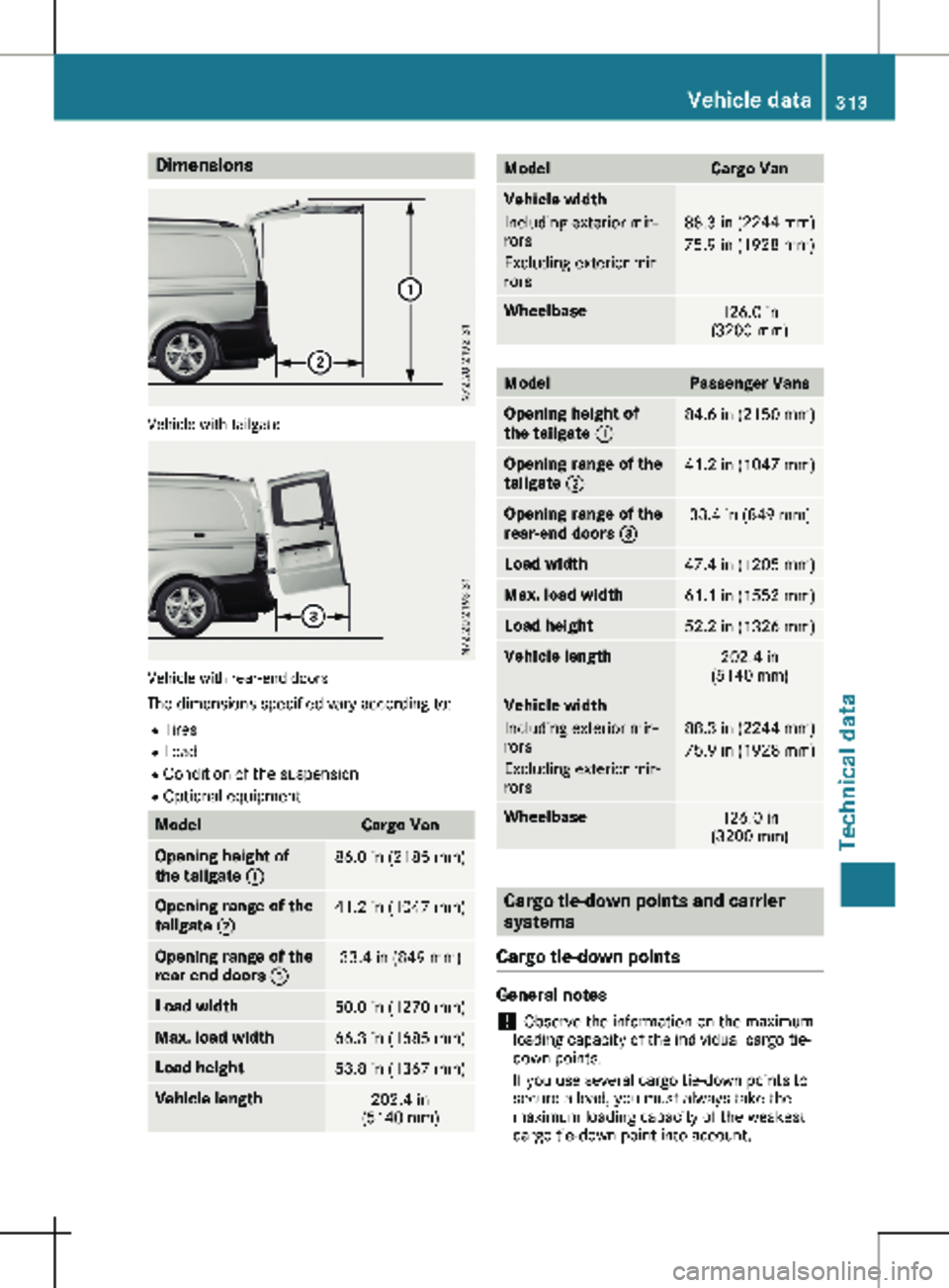
Dimensions
Vehicle with tailgate
Vehicle with rear-end doors
The dimensions specified vary according to:
R Tires
R Load
R Condition of the suspension
R Optional equipment Model Cargo Van
Opening height of
the tailgate :
86.0 in (2185 mm)
Opening range of the
tailgate ;
41.2 in (1047 mm)
Opening range of the
rear-end doors
= 33.4 in (849 mm)
Load width
50.0 in (1270 mm)
Max. load width
66.3 in (1685 mm)
Load height
53.8 in (1367 mm)
Vehicle length
202.4 in
(5140 mm ) Model Cargo Van
Vehicle width
Including exterior mir-
rors
Excluding exterior mir-
rors
88.3 in
(2244 mm)
75.9 in (1928 mm) Wheelbase
126.0 in
(3200 mm
) Model Passenger Vans
Opening height of
the tailgate :
84.6 in (2150 mm)
Opening range of the
tailgate ;
41.2 in (1047 mm)
Opening range of the
rear-end doors
= 33.4 in (849 mm)
Load width
47.4 in (1205 mm)
Max. load width
61.1 in (1552 mm)
Load height
52.2 in (1326 mm)
Vehicle length
202.4 in
(5140 mm
) Vehicle width
Including exterior mir-
rors
Excluding exterior mir-
rors
88.3 in
(2244 mm)
75.9 in (1928 mm) Wheelbase
126.0 in
(3200 mm
) Cargo tie-down points and carrier
systems
Cargo tie-down points General notes
! Observe the information on the maximum
loading capacity of the individual cargo tie-
down points.
If you use several cargo tie-down points to
secure a load, you must always take the
maximum loading capacity of the weakest
cargo tie-down point into account. Vehicle data
313
Technical data Z
Page 316 of 320
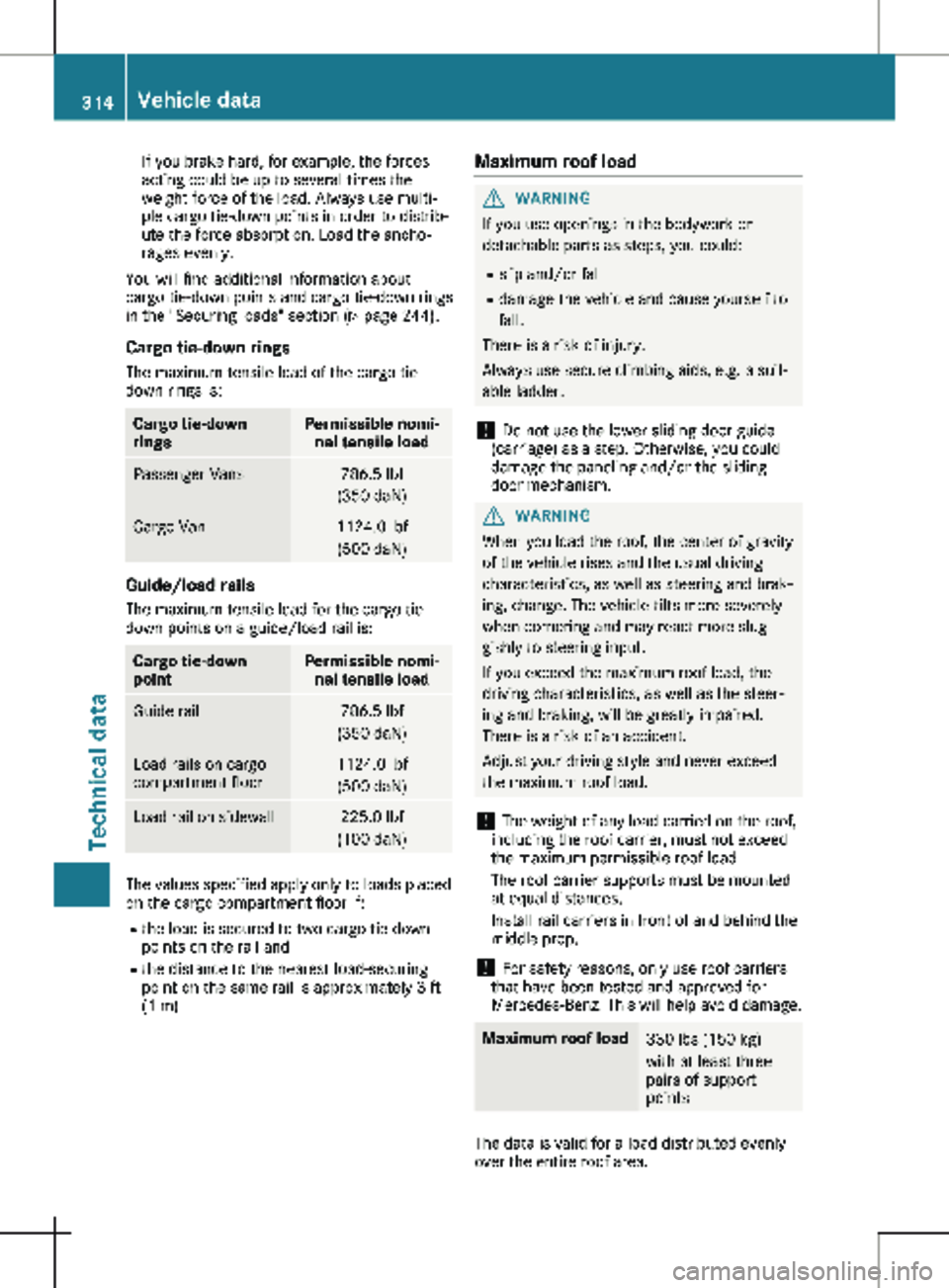
If you brake hard, for example, the forces
acting could be up to several times the
weight force of the load. Always use multi-
ple cargo tie-down points in order to distrib-
ute the force absorption. Load the ancho-
rages evenly.
You will find additional information about
cargo tie-down points and cargo tie-down rings
in the "Securing loads" section
(Y page 244).
Cargo tie-down rings
The maximum tensile load of the cargo tie-
down rings is: Cargo tie-down
rings Permissible nomi-
nal tensile load Passenger Vans 786.5 lbf
(350 daN) Cargo Van 1124.0 lbf
(500 daN) Guide/load rails
The maximum tensile load for the cargo tie-
down points on a guide/load rail is: Cargo tie-down
point Permissible nomi-
nal tensile load Guide rail 786.5 lbf
(350 daN) Load rails on cargo
compartment floor 1124.0 lbf
(500 daN) Load rail on sidewall 225.0 lbf
(100 daN) The values specified apply only to loads placed
on the cargo compartment floor if:
R the load is secured to two cargo tie-down
points on the rail and
R the distance to the nearest load-securing
point on the same rail is approximately
3 ft
(1 m) Maximum roof load G
WARNING
If you use openings in the bodywork or
detachable parts as steps, you could:
R slip and/or fall
R damage the vehicle and cause yourself to
fall.
There is a risk of injury.
Always use secure climbing aids, e.g. a suit-
able ladder.
! Do not use the lower sliding door guide
(carriage) as a step. Otherwise, you could
damage the paneling and/or the sliding
door mechanism. G
WARNING
When you load the roof, the center of gravity
of the vehicle rises and the usual driving
characteristics, as well as steering and brak-
ing, change. The vehicle tilts more severely
when cornering and may react more slug-
gishly to steering input.
If you exceed the maximum roof load, the
driving characteristics, as well as the steer-
ing and braking, will be greatly impaired.
There is a risk of an accident.
Adjust your driving style and never exceed
the maximum roof load.
! The weight of any load carried on the roof,
including the roof carrier, must not exceed
the maximum permissible roof load.
The roof carrier supports must be mounted
at equal distances.
Install rail carriers in front of and behind the
middle prop.
! For safety reasons, only use roof carriers
that have been tested and approved for
Mercedes-Benz. This will help avoid damage. Maximum roof load
330 lbs (150 kg)
with at least three
pairs of support
points
The data is valid for a load distributed evenly
over the entire roof area. 314
Vehicle data
Technical data